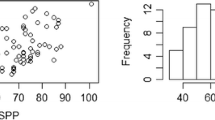Abstract
A logistic regression model is suggested for estimating the relation between a set of manifest predictors and a latent trait assumed to be measured by a set ofk dichotomous items. Usually the estimated subject parameters of latent trait models are biased, especially for short tests. Therefore, the relation between a latent trait and a set of predictors should not be estimated with a regression model in which the estimated subject parameters are used as a dependent variable. Direct estimation of the relation between the latent trait and one or more independent variables is suggested instead. Estimation methods and test statistics for the Rasch model are discussed and the model is illustrated with simulated and empirical data.
Similar content being viewed by others
References
Abramowitz, M., & Stegun, I. A. (Eds.). (1964).Handbook of mathematical functions. New York: Dover Publications.
Andersen, E. B. (1970). Asymptotic properties of conditional maximum likelihood estimates.Journal of the Royal Statistical Society, Series B, 32, 283–301.
Andersen, E. B. (1973). A goodness of fit test for the Rasch model.Psychometrika, 38, 123–140.
Andersen, E. B., & Madsen, M. (1977). Estimating the parameters of the latent population distribution.Psychometrika, 35, 357–374.
Anderson, J. A. (1972). Separate sample logistic discrimination.Biometrika, 59, 19–35.
Bock, R. D., & Aitkin, M. (1981). Marginal maximum likelihood estimation of item parameters: Application of an EM algorithm.Psychometrika, 46, 443–459.
Breslow, N. E., & Day, N. E. (1980).Statistical methods in cancer research, Vol. 1. The analysis of case-control studies. Lyon: IARC Scientific Publications.
Dixon, W. J. (1985).BMDP statistical software. Berkeley: University of California Press.
Fischer, G. H. (1974).Einführung in die Theorie Psychologischer Tests [Introduction into the theory of psychological tests]. Bern: Verlag Hans Huber.
Glas, C. A. W. (1988). The derivation of some tests for the Rasch model from the multinomial distribution.Psychometrika, 53, 525–546.
Glas, C. A. W. (1989).Contributions to estimating and testing Rasch models. Unpublished doctoral dissertation, Cito, Arnhem.
Goldstein, H. (1980). Dimensionality, bias, independence and measurement scale problems in latent trait test score models.British Journal of Mathematical and Statistical Psychology, 33, 234–260.
Lord, F. M. (1980).Applications of item response theory to practical test problems. Hillsdale, NJ: Erlbaum.
Lord, F. M. (1984).Maximum likelihood and bayesian parameter estimation in IRT (RR-84-30-ONR). Princeton, NJ: Educational Testing Service.
Lord, F. M., & Novick, M. R. (1968).Statistical theories of mental test scores. Reading: Addison-Wesley.
Molenaar, I. W. (1983). Some improved diagnostics for the Rasch model.Psychometrika, 49, 49–72.
Prentice, R. L., & Pyke, R. (1979). Logistic disease incidence models and case-control studies.Biometrika, 66, 403–411.
Rao, C. R. (1973).Linear statistical inference and its applications (2nd ed.). New York: Wiley.
Rigdon, S. E., & Tsutakawa, R. K. (1983). Parameter estimation in latent trait models.Psychometrika, 48, 567–574.
van Houwelingen, J. C., & le Cessie, S. (1988). Logistic regression: A review.Statistica Neerlandica, 42, 215–232.
Zwinderman, A. H. (in press). A two stage Rasch model approach to dependent item responses: An application of constrained item response models.Methodika.
Zwinderman, A. H., Verhey, Th. J. M. Hermans, J., Kaptein, A. A., & Mulder, J. D. (in press). Application of the Rasch model for the prescription behavior of general practitioners.Journal of Clinical Epidemiology.
Author information
Authors and Affiliations
Rights and permissions
About this article
Cite this article
Zwinderman, A.H. A generalized rasch model for manifest predictors. Psychometrika 56, 589–600 (1991). https://doi.org/10.1007/BF02294492
Received:
Revised:
Issue Date:
DOI: https://doi.org/10.1007/BF02294492




